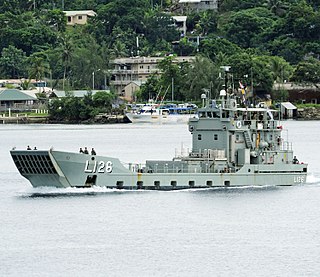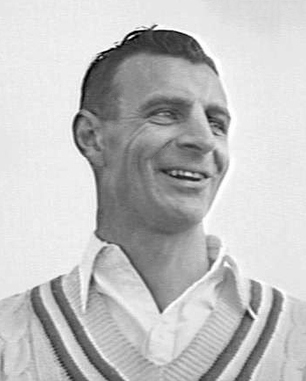
The Australian Army has operated numerous ships and watercraft.

The Australian Army has operated numerous ships and watercraft.
| Contents: A B C D E F G H I J K L M N O P Q R S T U V W X Y Z |

HMAS Balikpapan was the lead ship of the Balikpapan class of heavy landing craft (LCH). Ordered in 1969, Balikpapan entered service with the Australian Army Water Transport Squadron in late 1971. After this, the decision to place all seagoing Army vessels under the control of the Royal Australian Navy (RAN) saw Balikpapan transferred and commissioned in 1974; the last of the eight-vessel class to enter RAN service. Balikpapan was placed in reserve in 1985, but was reactivated three years later. During late 1999 and early 2000, the vessel was part of the INTERFET peacekeeping taskforce, and made additional deployments to East Timor in 2001 and 2006. On 12 December 2012, Balikpapan was retired from RAN service.

The Battle of the Bismarck Sea took place in the South West Pacific Area (SWPA) during World War II when aircraft of the U.S. Fifth Air Force and the Royal Australian Air Force (RAAF) attacked a Japanese convoy carrying troops to Lae, New Guinea. Most of the Japanese task force was destroyed, and Japanese troop losses were heavy.

The Balikpapan class is a class of eight heavy landing craft. All eight were built by Walkers Limited for the Australian Army in the early 1970s. A reorganisation of watercraft responsibilities in the Australian military meant the landing craft were operated by the Royal Australian Navy (RAN), with seven commissioned directly into RAN service during 1973 and 1974, and lead ship Balikpapan transferred from the army to the navy. During the leadup to the independence of Papua New Guinea in 1975, two of the vessels were transferred to the new Papua New Guinea Defence Force (PNGDF).

Operation Chronicle was the Allied invasion of Woodlark and Kiriwina Islands, in the South West Pacific, during World War II. The operation was a subordinate action that formed part of the wider Operation Cartwheel, the advance towards Rabaul. An early planning name for this operation was Operation Coronet. Preliminary actions commenced on 23–24 June 1943 when small reconnaissance parties were landed on both islands. The main operation was executed without opposition on 30 June 1943. Around 16,800 personnel took part, divided into two forces. The United States Army provided the majority of ground troops, which were supported by a United States Marine Corps defense battalion as well as U.S. and Australian aircraft and naval vessels.

RAAF Base Rathmines is a heritage-listed former RAAF Second World War seaplane base and now used as community venues, sports venues and a visitor attraction at Dorrington Road, Rathmines, City of Lake Macquarie, New South Wales, Australia. It was in use as an RAAF base from 1939 to 1961. It is also known as Rathmines Park, former RAAF Seaplane Base, Flying Boat Base, Rathmines Aerodrome and Catalina Base. The property is owned by Australian Christadelphian Bible School, Disability Life Enrichment, Don Geddes Nursing Home and Lake Macquarie City Council. The remains of the former air base was added to the New South Wales State Heritage Register on 25 November 2005.

Mungalalu Truscott Airbase or Truscott-Mungalalu Airport, which during World War II was known as Truscott Airfield is today a commercial airport in the remote Kimberley region of Western Australia.

No. 35 Squadron is a Royal Australian Air Force (RAAF) transport unit. Formed in 1942, No. 35 Squadron operated during World War II, transporting cargo and passengers around Australia, New Guinea and the Netherlands East Indies, equipped with a variety of aircraft including the Douglas Dakota. It was disbanded after the war, but was re-raised in the 1960s for service during the Vietnam War, flying transportation and resupply operations with DHC-4 Caribous in support of Australian and US forces. The squadron was subsequently augmented with rotary-wing aircraft, operating UH-1 Iroquois in both the transportation and gunship roles. In the late 1980s, the squadron returned to a solely fixed-wing transport role. It ceased operations in 2000, but was re-raised in January 2013. It began re-equipping with C-27 Spartan transports in 2015.

Madang Airport, is an airport located in Madang, Papua New Guinea.

No. 78 Squadron was a Royal Australian Air Force (RAAF) fighter squadron of World War II. It was formed in July 1943 as part of expansion of the RAAF's fighter force, and was assigned to mobile striking forces for the duration of the war.
I-177 was an Imperial Japanese Navy Kaidai-type cruiser submarine of the KD7 subclass commissioned in 1942. She served during World War II, patrolling off Australia, taking part in the New Guinea campaign, operating in the North Pacific, and participating in the Palau campaign before she was sunk by the destroyer escort USS Samuel S. Miles (DE-183) in 1944, with no survivors.

Stanley George Sismey was an Australian cricketer. Sismey, who achieved the rank of Squadron Leader in the Royal Australian Air Force (RAAF) during World War II, was the official Commanding Officer of the Australian Services XI that played England in the Victory Test series that followed VE Day in 1945. He was not, however, the on-field captain, an honour bestowed upon pre-war Test cricketer Lindsay Hassett. Sismey was the team's wicketkeeper and a middle order batsman during the five unofficial Test matches.

The Royal Australian Corps of Transport (RACT) is an administrative corps within the Australian Army. The RACT is ranked tenth in seniority of the corps of the Australian Army, and is the most senior logistics corps. It was formed on 1 June 1973 as an amalgamation of the Royal Australian Army Service Corps (RAASC) and Royal Australian Engineers Transportation Service. The RACT is responsible for the operation of army surface transport assets, movement control, terminal and postal services, and Army aspects of air logistic support.
The Australian landing ship medium Harry Chauvel was a United States Navy landing ship medium which was later sold to Australia and operated by the Australian Army.
The Australian landing ship medium Brudenell White was a United States Navy landing ship medium which was later sold to Australia and operated by the Australian Army.

The Battle of Sio, fought between December 1943 and March 1944, was the break-out and pursuit phase of General Douglas MacArthur's Huon Peninsula campaign, part of the New Guinea campaign of World War II.
The Australian Landing Craft 50 or ALC 50 was a class of Landing Craft Utility operated by the Australian Army in the 1960s.

The Landing at Jacquinot Bay was an Allied amphibious operation undertaken on 4 November 1944 during the New Britain Campaign of World War II. The landing was conducted as part of a change in responsibility for Allied operations on New Britain. The Australian 5th Division, under Major General Alan Ramsay, took over from the US 40th Infantry Division, which was needed for operations in the Philippines. The purpose of the operation was to establish a logistics base at Jacquinot Bay on the south coast of New Britain to support the 5th Division's planned operations near the major Japanese garrison at Rabaul.
The 32nd Small Ship Squadron, Royal Australian Engineers was an amphibious unit of the Royal Australian Engineers. They were formed in 1959 to operate the four LSM-1 class Landing Ship Medium purchased from the United States Navy. The ships were sold in 1971 and the unit was disbanded.
The Landing on Long Island in the Territory of New Guinea was part of the Huon Peninsula campaign, a series of operations that made up Operation Cartwheel, General Douglas MacArthur's campaign to encircle the major Japanese base at Rabaul. Located at the northern end of the Vitiaz Strait, Long Island was an important staging point for Japanese barges moving between Rabaul and Wewak until 26 December 1943, when a force of 220 Australian and American soldiers landed on the island. It was not occupied by the Japanese at the time, and there was no fighting. At the time, it represented the furthest Allied advance into Japanese-held territory. It was developed into a radar station.